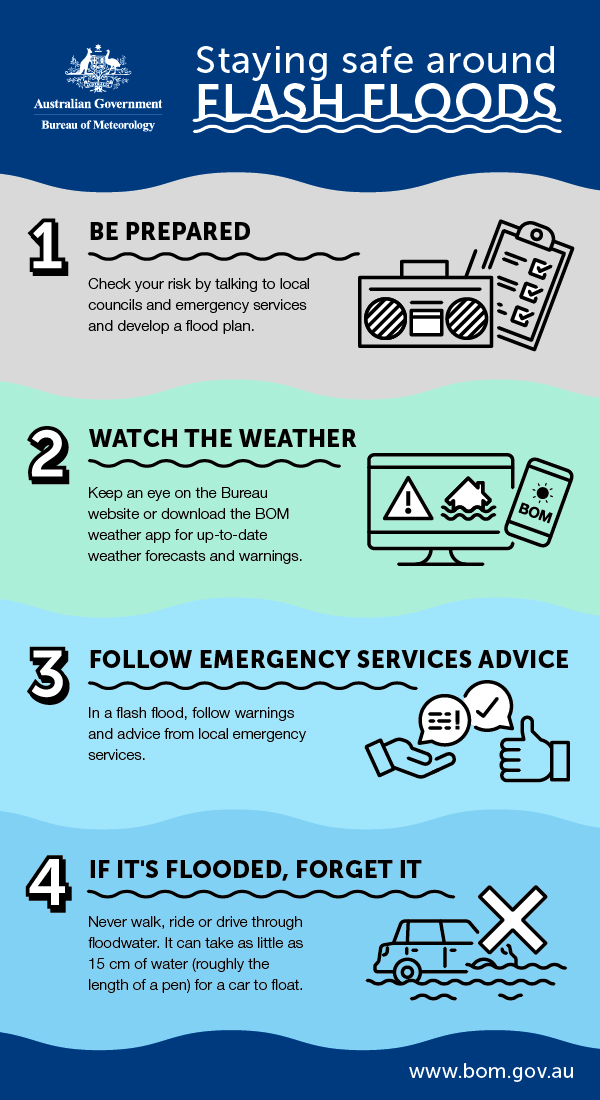Flash Flood Safety: A Guide To Understanding And Responding To Flood Warnings

Table of Contents
Understanding Flash Flood Risks
Flash floods develop rapidly, often with little warning, making preparedness paramount. Understanding your risk is the first step towards effective flash flood safety.
Identifying High-Risk Areas
Geographical location significantly influences flash flood risk. Certain areas are inherently more susceptible to these devastating events.
- Examples of high-risk areas:
- Areas near rivers, streams, and creeks, especially those with steep slopes.
- Low-lying areas with poor drainage, including urban areas with inadequate infrastructure.
- Mountainous regions, where heavy rainfall can quickly overwhelm drainage systems.
- Dry creek beds or washes, which can channel massive amounts of water during storms.
- Maps and resources to check flood risk: Utilize online resources such as the FEMA Flood Map Service Center (https://msc.fema.gov/portal/home) to determine your property's flood risk. Your local emergency management agency also provides valuable information specific to your area.
- Types of land prone to flash floods: Steep slopes contribute to rapid water runoff, while dry creek beds can become raging torrents in minutes. Understanding the terrain around your home is crucial for assessing your risk.
Recognizing Flash Flood Warning Signs
Recognizing warning signs, both meteorological and visual, is critical for timely action and effective flash flood safety.
- Meteorological indicators:
- Heavy or persistent rainfall, especially in a short period.
- Rapidly rising water levels in rivers, streams, or creeks.
- Overflowing rivers and streams exceeding their banks.
- Visual cues:
- Mudslides and debris flows, indicating significant water movement in upstream areas.
- Sudden increases in water flow in normally dry areas.
- Specific warning signs from the National Weather Service: Pay close attention to weather alerts and warnings issued by the National Weather Service (NWS) and your local news. Understanding the different levels of flood warnings (advisory, watch, warning) is essential.
Developing a Flash Flood Preparedness Plan
Proactive planning is the cornerstone of effective flash flood safety. A well-defined plan can save lives and mitigate property damage.
Creating a Family Emergency Plan
A comprehensive family emergency plan is vital, ensuring everyone knows what to do in a flash flood situation.
- Steps for creating a plan:
- Identify potential evacuation routes and safe locations, preferably higher ground.
- Designate a meeting point outside the affected area.
- Include emergency contact information for family members and relevant authorities.
- Develop a communication plan, including methods to contact each other if separated.
- Consider the needs of children, the elderly, and individuals with disabilities.
- Designated safe locations: Pre-identify multiple potential safe locations, considering distance and accessibility.
- Packing an emergency kit: Ensure everyone knows the location and contents of your emergency kit.
Building a Flash Flood Emergency Kit
A well-stocked emergency kit is crucial for survival during and after a flash flood.
- Essential items:
- Water (at least one gallon per person per day for several days)
- Non-perishable food (easy-to-prepare items)
- First-aid kit (including any necessary medications)
- Flashlights and extra batteries
- Battery-powered or hand-crank radio
- Important documents (waterproofed copies of identification, insurance, and medical records)
- Specific item recommendations: Consider specific dietary needs and any pre-existing medical conditions when assembling your kit.
- Where to store the kit: Keep your kit in a readily accessible and easily transportable location. Regularly check and update its contents.
Responding to a Flash Flood Warning
Knowing how to respond to a flash flood warning is crucial for flash flood safety. Time is of the essence.
Evacuation Procedures
If a flash flood warning is issued, act immediately. Evacuation may be necessary to ensure safety.
- Safe evacuation routes: Use pre-determined evacuation routes and heed official instructions.
- Heeding official warnings: Follow directions from emergency responders and local authorities.
- Seeking higher ground promptly: Move to the highest point possible, away from floodwaters.
- Different modes of transportation during evacuation: If possible, use a vehicle, but be aware that roads may become impassable. Consider alternative transportation if your vehicle is at risk.
- What to do if trapped: If trapped, try to find a sturdy object to cling to, signal for help if possible, and stay aware of your surroundings.
- Assisting neighbors: Offer assistance to neighbors, especially the elderly or those with disabilities, but prioritize your own safety.
Staying Safe During a Flash Flood
If caught in a flash flood, your actions can significantly impact your safety.
- Finding high ground: Move to the upper floors of a sturdy building or seek higher ground immediately.
- Moving to the second story of a house: If in a house, move to the second story, if possible, to avoid rising floodwaters.
- Not driving through floodwaters: Never drive or walk through floodwaters, as the depth and current may be deceivingly strong.
- Potential dangers of floodwaters: Floodwaters can contain hazardous materials, debris, and electric currents.
- Immediate actions to take: Stay informed about weather conditions, monitor floodwaters, and avoid contact with floodwater.
- How to help others safely: Help those in need, but only if you can do so without endangering yourself.
Conclusion
This guide has highlighted the importance of flash flood safety through understanding risks, developing preparedness plans, and knowing how to respond to warnings. By taking proactive steps, you can significantly reduce the risks associated with flash floods and protect yourself and your community. Remember, effective flash flood preparedness isn't just about reacting to a warning; it's about being prepared before the warning comes.
Call to Action: Learn more about flash flood safety and prepare your family today. Don't wait for a warning – take control of your flash flood safety now! Visit your local emergency management agency's website for more information and resources related to flash flood safety in your area.

Featured Posts
-
 Live Streaming And Jam Tayang Sprint Race Moto Gp Inggris Di Trans7 Kejutan Rins Jatuhnya Marquez
May 26, 2025
Live Streaming And Jam Tayang Sprint Race Moto Gp Inggris Di Trans7 Kejutan Rins Jatuhnya Marquez
May 26, 2025 -
 Naomi Kempbell Svyatkuye 55 Richchya Divitsya Yiyi Naykraschi Foto
May 26, 2025
Naomi Kempbell Svyatkuye 55 Richchya Divitsya Yiyi Naykraschi Foto
May 26, 2025 -
 Real Madrid Yildizlarina Uefa Dan Sorusturma
May 26, 2025
Real Madrid Yildizlarina Uefa Dan Sorusturma
May 26, 2025 -
 Mercedes Ferstapen I Pithanotita Metagrafis Eksasthenei
May 26, 2025
Mercedes Ferstapen I Pithanotita Metagrafis Eksasthenei
May 26, 2025 -
 Kapan Moto Gp Inggris 2025 Jadwal Terbaru Balapan
May 26, 2025
Kapan Moto Gp Inggris 2025 Jadwal Terbaru Balapan
May 26, 2025
Latest Posts
-
 West Des Moines School Board Appoints New Valley High School Principal
May 30, 2025
West Des Moines School Board Appoints New Valley High School Principal
May 30, 2025 -
 The Ripple Effect Trump Tariffs And The Future Of Indian Solar Exports To Southeast Asia
May 30, 2025
The Ripple Effect Trump Tariffs And The Future Of Indian Solar Exports To Southeast Asia
May 30, 2025 -
 Analyzing The Impact Of Trump Tariffs Challenges For Indian Solar Exporters In Southeast Asia
May 30, 2025
Analyzing The Impact Of Trump Tariffs Challenges For Indian Solar Exporters In Southeast Asia
May 30, 2025 -
 Analiza Kampanii Wyborczej Mentzena Wybory Prezydenckie 2025
May 30, 2025
Analiza Kampanii Wyborczej Mentzena Wybory Prezydenckie 2025
May 30, 2025 -
 Wybory Prezydenckie 2025 Strategia Mentzena Sukces Czy Porazka
May 30, 2025
Wybory Prezydenckie 2025 Strategia Mentzena Sukces Czy Porazka
May 30, 2025
